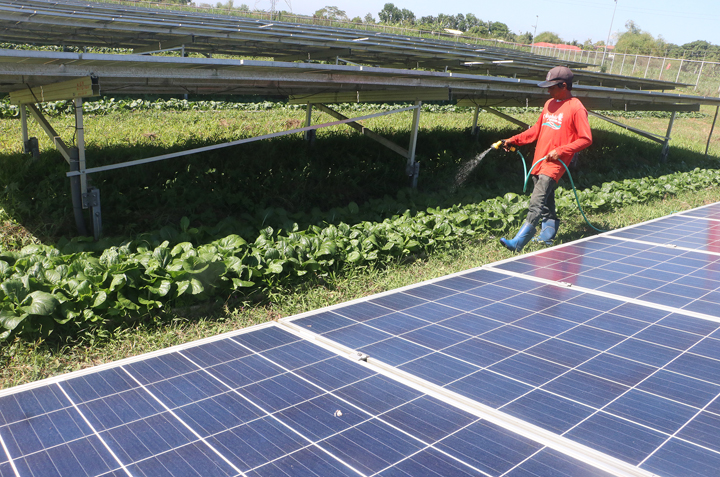‘THERE’S only a little time left,” said Dr. Rodel Lasco, country coordinator of World Agroforestry Center in his address on the issue of climate change at the recent fifth Asean Plus Three Junior Science Odyssey held at the University of the Philippines Los Baños in Laguna.
“Your generation will inherit this problem [on climate change] and it is, indeed, your generation who will have to wrestle and seek solutions to this problem,” he said.
Greenhouse-gas scenario
Fossil fuels make up most of the greenhouse gases (GHG) that human activities emit at 65 percent. With this rate, it is likely the planet will be warmer by up to 5 degrees Celsius for the next 100 years.
The best-case scenario, according to Intergovernmental Panel on Climate Change (IPCC), is to control the emissions to achieve a rise in temperature of only about 2˚C.
In the last century, experts have said evidence have shown the Earth has warmed over unprecedented levels. A climate-change synthesis report by the IPCC in 2014 indicated that, “It is extremely likely that more than half of the observed increase in global average surface temperature from 1951 to 2010 was caused by the anthropogenic [based on human activities] increase in GHG concentrations and other anthropogenic forcings together.”
This means that in only half a century, the contribution of environmental pollutants due to human activities has increased surface temperatures for more than a degree Celsius.
Carbon dioxide (CO2), methane and nitrous oxide are the gases that warm the planet. “Without these gases, our planet will be 30˚C cooler than it is today,” emphasized Lasco, who has a field of specialization on forestry and climate-change mitigation. “Can you imagine living in a planet 30˚C cooler than now? That’s like having an average temperature of minus 20˚C all the time,” he exclaimed.
Forest importance for climate-change adaptation and mitigation
There are three concentrations of tropical forests in the world—the Amazon, the Congo River basin and the Southeast Asia rainforest. Southeast Asia is known for its rainforests, most especially Indonesia, which has the largest area.
“There is a lot of uncertainty how climate change may affect our forest resources,” Lasco said in an interview with the BusinessMirror. The ecosystem is very well connected to us all that when climate change gets in the picture, it is important for science to learn and assess the consequences.
Lasco emphasized that planting more trees is the answer if we want to adapt and help mitigate climate change. Through the natural process of photosynthesis, trees absorb light and convert the carbon dioxide to emit oxygen and store carbon inside them in the form of biomass. “This biomass leads to carbon sequestration—carbon stock stored in the biomass,” Lasco explained.
If trees die, they emit the carbon stored inside them. “Hence, we need to plant more trees for it to be absorbed again,”he said.
Lasco added that deforestation is one of the leading causes of GHG emissions. “Ten biliion to 12 billion tons of CO2 are released per year due to deforestation, that is loss of forest, as well as through agriculture, such as livestock, soil and nutrient management,” Lasco said.
Sustaining the number of trees is a must. Lasco told the BusinessMirror: “We are protecting our forest by aggressively planting more trees.”
The consequences of deforestation would greatly impact the country with extreme weather situations, such as wetter and drier seasons. “For example, in the Philippines, the projection is that Luzon and the Visayas coud be wetter, but Mindanao could be drier,” Lasco said. “So geographically, some will be drier or wetter, but at the same time, it could be seasonal, where it can be wetter during the wet season or drier on the dry season.”
Agroforestry and green buildings
The Philippine forest cover has declined in the last 100 years. “Right now, we have 20-percent forest cover [compared to]90 percent before,” Lasco told the BusinessMirror. “We lost 50 percent in the last 100 years and we need to bring it back,” he added.
Yet, as the population in the country does not plummet, the need for food is also a priority. Hence, a combination of agriculture and forestry is studied and promoted. “There are approaches and technologies where you can combine trees and crops rather than separate agriculture and trees,” Lasco said. There will be more ecosystem services instead of only one commodity that can be produced.
Also, agricultural technologies can be incorporated to mitigate the release of GHG gases, such as methane in ricefields. “When the rice [field] is flooded, they emit methane, but there are new technologies right now that provide alternate wetting and drying,” Lasco said.
In an urban setting, such as Manila, many buildings can be converted as green buildings. “Believe it or not, buildings have the highest potential to mitigate climate change,” Lasco beamed.
Buildings with trees on the rooftop or on its sides could be considered. Since most buildings are airconditioned, and in other countries, heated during winter season, they also emit more GHG gases. “We need to address how we construct our buildings,” Lasco said in a challenge to architects and engineers.
Image credits: Gerry Palad/S&T Media Service




































